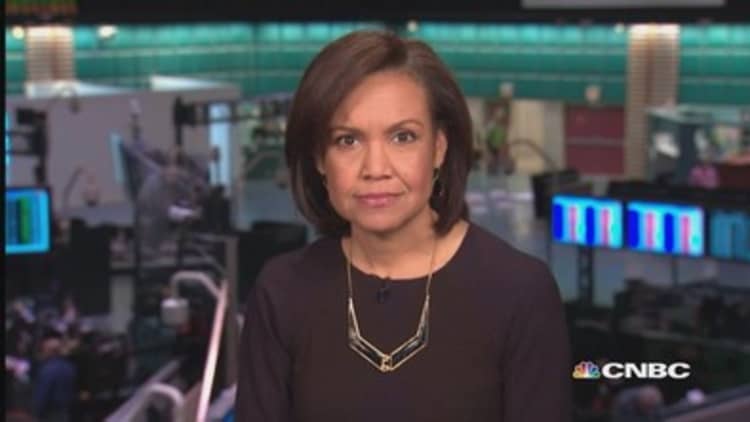
As tumbling U.S. oil prices bring a new round of pain for producers, OPEC appears to be far from blinking.
The cartel helped fan the plunge in already-falling crude prices last autumn when it refrained from trimming its output and let prices drop. At the time, some industry analysts expected OPEC to move by its June meeting to shore up prices, and while that could still happen, there are no signs of it.
"They'll basically go to Vienna for nice weather and good shopping and go back home," said Fadel Gheit, Oppenheimer energy analyst.
West Texas Intermediate futures for April settled Monday at $43.88 per barrel, a decline of 2.1 percent. Brent firmed slightly in late trading and was at $54.22 per barrel. Prices were under pressure on speculation there could be a nuclear deal with Iran, but also high levels of U.S. supply are weighing on the market.
Read MoreU.S. oil settles at six-year lows
When the Organization of the Petroleum Exporting Countries held off cutting output, it took aim at higher-cost producers, particularly U.S. shale drillers. Saudi Arabia, the biggest exporter and swing producer, vowed that it would not be alone in cutting production.
OPEC, in a monthly report Monday, signaled that it may need to wait longer to see the impact on U.S. shale. It said that U.S. oil production could slow by late in the year due to weak prices, and it left its forecast for non-OPEC supply unchanged.
Read MoreBP CEO: Decline is going to be painful
Besides U.S. production, geopolitical events could easily move crude prices. If Iran were to strike a deal with the U.S. and five other nations to end its nuclear program, oil would likely rise even though it would probably not be able to bring in much new capacity very quickly.
OPEC has also been divided with some producers, like Venezuela, desperate for higher prices.
"One of the reasons OPEC is in disarray is there are six OPEC countries that are hurting the most from low oil prices that cannot afford to cut production," said Gheit. But the Gulf nations, led by Saudi Arabia, control more than 50 percent of OPEC output and they are not ready to change course.
Cartel watchers say Saudi Arabia appears to have softened its rhetoric but does not appear to be close to taking action to stem falling prices.
U.S. oil production, meanwhile, has remained robust, rising to a four-decade high last week of 9.3 million barrels a day. Gheit said it could be the U.S. industry that blinks first, with many companies expecting losses due to the collapse in oil prices.
"The shale industry is less than 10 years old. It has not matured enough. It has never been through a cycle before. It doesn't know what this cycle means. It's like teenagers experimenting with things in life they've never been through. ... If oil prices don't rebound in the next three to six months, we are going to see a lot of mergers and acquisitions. The problem is for every potential buyer, there are five potential sellers," Gheit said.
Bhushan Bahree, senior director, OPEC Middle East Research at IHS, said the U.S. industry has helped create a new "oil order" and it's now a big factor in terms of prices.
"It's been passed on to them in the sense that if they have the swing role, they can't react as fast as others. There will be much more volatility," he said. "They're the inadvertent swing supplier now."
Saudi Arabia, the traditional swing producer, can have a much swifter impact on oil production than the dozens of U.S. companies that all answer independently to shareholders and other owners. The U.S. industry has become a more powerful lever when it comes to oil prices but a far more unpredictable one.
"There's definitely going to be a lagged response in terms of production. It's not going to happen immediately," said Energy Aspects crude and products analyst Dominic Haywood. He noted that U.S. production has widely been expected to slow down in the second half, but some analysts say it could stay at high levels with new growth more affected.
Read MoreThis signals more oil field mergers may be coming
The market has also been eyeing shrinking storage capacity for U.S. crude, as more and more oil is produced. The storage levels at Cushing, Oklahoma, the physical storage hub for WTI futures, has been a particular concern, and the market fears a fire sale if capacity is reached.
"There's a lot of crude storage that's not in Cushing," said Haywood, noting the fears might be overblown. "While it's a good barometer, it's hard to say where the bottom is going to be. The key thing to look at is volatility. No one knows what the impact on the oil price is going to be in the medium term, long term. Even people taking crude out of the ground don't know how this is going to affect their decline rate."
The U.S. industry has shut down rigs and slashed capital spending, but for now production remains high. "You could easily see 5 or 6 percent swings in price (daily), and I think that's going to be common place, just because there's so much uncertainty," said Haywood. He said U.S. drillers are still in the process of negotiating new, lower terms with service providers.
"The industry is definitely in a state of flux at the moment. If the producers aren't too sure what the impact is going to be, it's going to be hard for the people who are speculating," he said.


